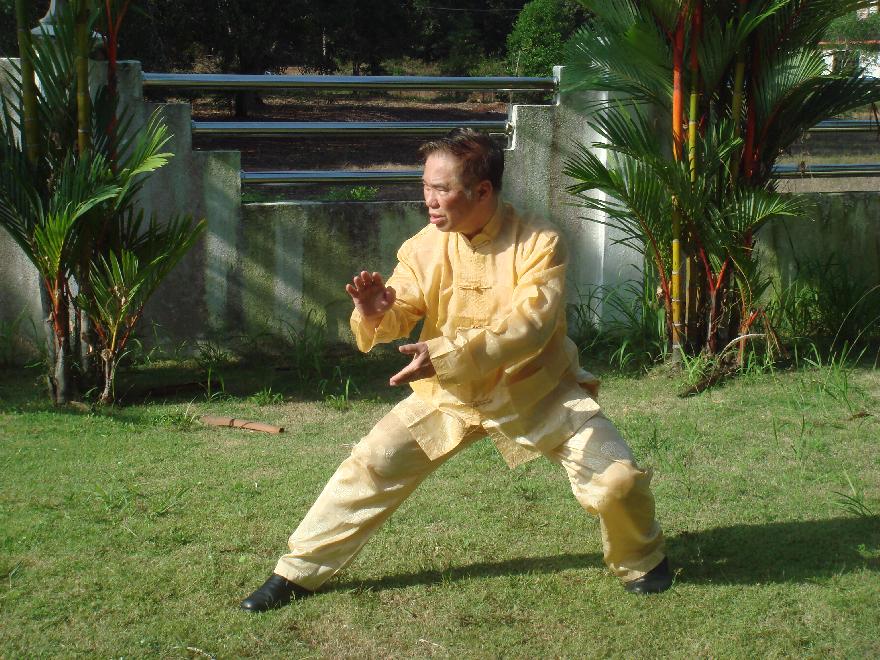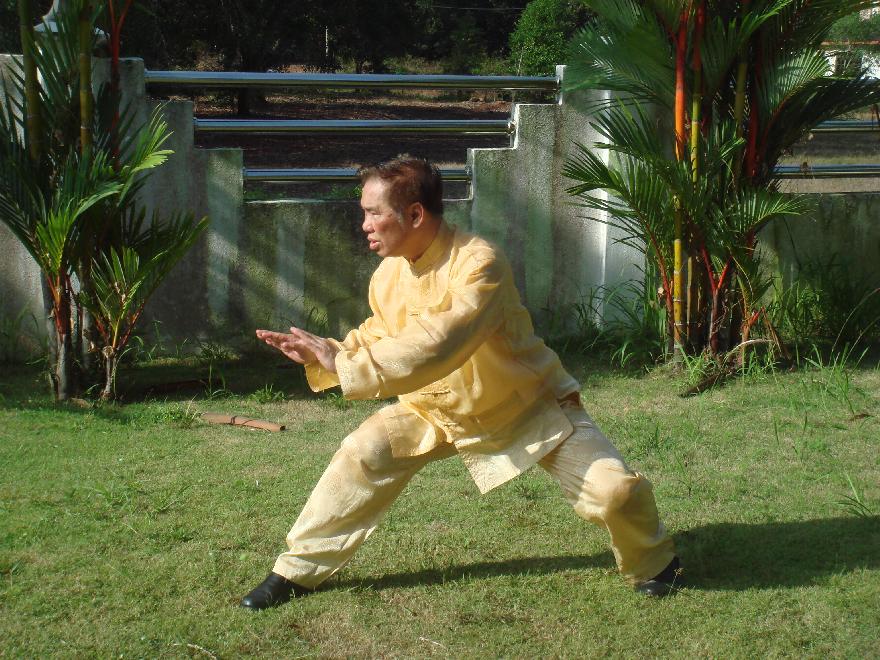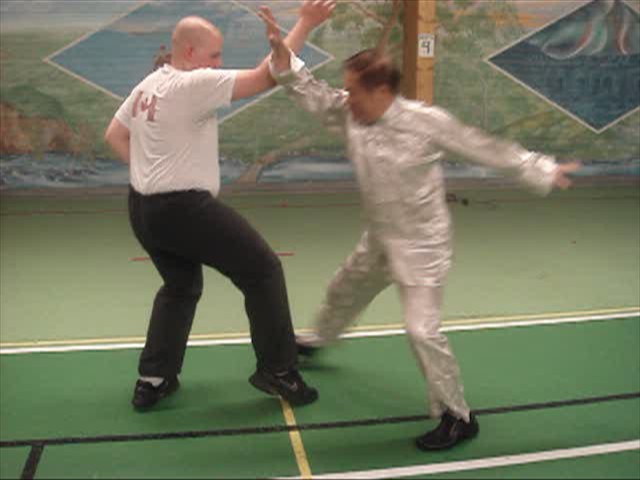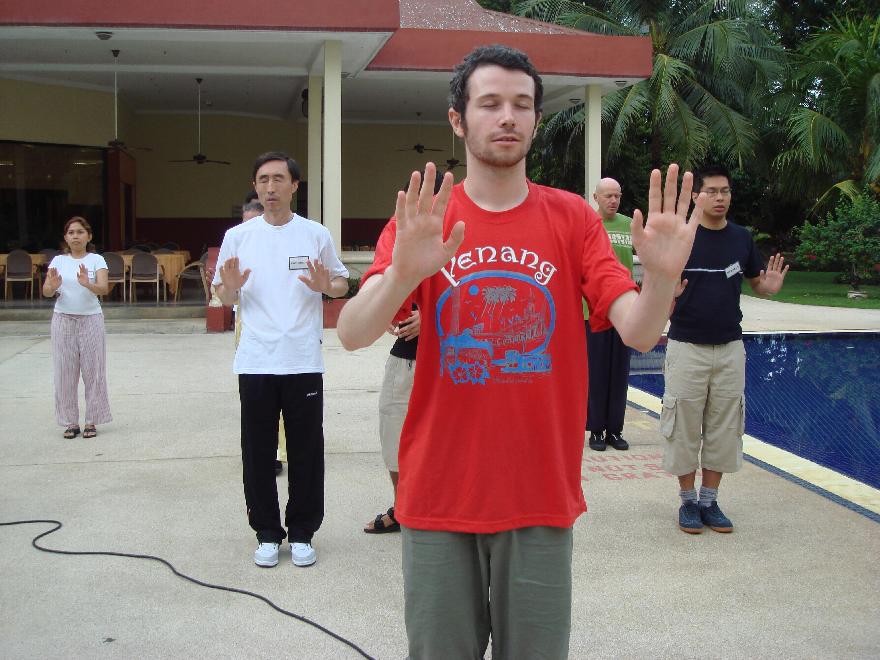SELECTION OF QUESTIONS AND ANSWERS
MARCH 2011 PART 1

Double Dragons Play with Pearl
Question 1
If I meet an opponent who has much internal force and uses his strong arms to tie me in, I find it hard to apply my combat sequences on him. What are your thoughts on this, sifu?
— Sifu Robin Gamble, Thailand
Answer
I am glad you ask this question. This was a common question in the past. All past masters had powerful arms. Hence, this was a question advanced practitioners soon faced as they progressed to spar at masters' level. They had to go pass the masters' powerful arms to join their ranks.
This was a good thing for us, because this means the past masters would have left a lot of material for us to benefit from -- if we know where to look for the material. Do you know where the material can be found?
Yes, some of the material can be found in records of past fights, which may not be easily available. But the biggest bulk of the material is easily and presently available, but it is found in places where most people least expect it. Do you know where it is?
It is found in classical kungfu sets. If you take a moment to reflect, you will find that this is logical because kungfu sets represent the crystallization of techniques, tactics and strategies that masters in the past used in their fighting. They must have gone past many opponents with strong arms before they could become masters.
I have a lot of classical kungfu sets. Even if one does not know many classical kungfu sets, today he can easily learn them from books or even form the internet. But he will not know the tactics and strategies hidden in the open in the classical sets. Even those who have practiced their classical sets for years do not know how to use the techniques in their sets for simple combat, least of all know the tactics and strategies for sophisticated tasks like getting past powerful arms.
But after knowing the principles involved which I shall share with you, you and other instructors and advanced students in our school will know how to decipher these tactics and strategies from the classical kungfu sets you have learnt or will learn. You will add an interesting dimension to the learning of classical kungfu sets.
Incidentally, your question comes at an opportune time in the development of our school. We have completed the first phase of laying the foundation. We are now ready to move to a more advanced phase where we can enjoy the depth and richness of Shaolin and Taijiquan. Thus, I have begun teaching many classical kungfu sets.
Question 2
The only counter I can think of is developing a quick break in arm contact and then using agility to move away in different angles, then using confusing angles to attack. This would avoid his strong points of very good hand sensitivity and forward momentum. What tactics or strategies you would advise me to use in this scenario?
Answer
The counter you suggest is reasonable, but it is only one of many ways to go pass the strong arms of opponents and defeat them. In fact, every kungfu style has its own special ways to go past strong opponents, otherwise that style would not survive to this day.
Do you know what style would your suggestion belong to? Think of the main features of this style: quick break away, agile movements, confusing angles to attack. Yes, it is Monkey Style. Nick and even Martin would pluck some peaches.
Now, let us look at a style you are excellent in -- Taijiquan. What Taijiquan features you can use to meet an opponent with internal force and strong arms to stop your combat sequences? In fact there are many because it is the forte of Taijiquan to overcome bigger and stronger opponents.
What Taijiquan techniques would be most suitable for this purpose? Of course, they are its most typical techniques. Why? Because it is typical of Taijiquan to overcome bigger, stronger opponents. And its typical techniques are found in "Grasping Sparrow's Tail".
In fact I have just posted some videos on my website on this topic. Please see especially Using Taijiquan Mechanics to Overcome Bigger, Stronger Opponents.
If a strong opponent strikes you or pushes at you, don't retreat your steps. Stay your ground but sink back your body, rotate your waist, use "Immortal Waves Sleeves" to deflect his attack in an arc, and then turn it round to counter-strike him. This is most typical of Taijiquan. This is what we first do when we practice Pushing Hands.
Now, if he charges at you with full force, what would you do? If the attack is medium range (as he charges at you, it won't be short range), just sink your stance and pull him down with his head or chest hitting your front knee, employing "Black Bear Sinks Hips". Then dislocate his head, or appear to, using "Double Dragons Play with Pearl", letting him fall onto the ground with your hands on his head under control.
If his attack is long range, move a step back and simultaneously apply "Black Bear Sinks Hips" as before, or "Old Eagle Catches Snake" to fell him face-on onto the ground. Finish him off with "Double Dragon Plays with Pearl" on his head.
If he grips your arm, use "Double Dragon Plays with Pearl" or "Push Boat According to Flow of Stream" to dislocate his wrist. Swiftly move to his side or back and finish him off with "Double Dragon Plays with Pearl" on his head.
If he kicks at you, that would be easy. Sink back your stance using "Strike Tiger Poise", and let his kick pass. Immediately move in to fell him using "Carry Tiger Back to Mountain", and finish him off with a combat-ending strike while he is on the ground.
These are techniques. If you use these techniques haphazardly like many ordinary martial artists do, in a hit-and-run-one-pattern-a-time manner, these techniques are unlikely to be effective. You need to use tactics and strategies to implement your techniques effectively.
A good strategy is to engage him in full or at least frequent arm contact! Isn't this playing into this strength? Yes, if you use Monkey Style. But no, if you use Taijiquan. In fact, in Taijiquan you are turning his strength into his weakness! This is the beauty and profundity of Taijiquan. Remember the forte of Taijiquan is to beat a bigger, stronger opponent. Precisely because of his bigger size and strength, you beat him. This is applying the principle of "minimum force against maximum strength."
A good tactic is to let him attack, then keep contact with him. If he doesn't attack, you make a false attack, the purpose of which is not to strike him but to tempt him into contact. This is the principle of "false-false, real-real".
When you are in contact with him, do not make your decisive strike too soon. Stay with him for a while, and flow with him. Let him attack first, then turn the table back to him. This is the principle of "starting later, but arriving earlier".
If he does not attack, you can make false moves to tempt him to respond. Then you follow up from his responses. He may be big and strong like a bull, but with Taijiquan you can tie a rope though his nose and lead him round and round.

Black Bear Sinks Hips
Question 3
Another issue is that the opponent's forward movement together with his strong arms tying my hands up, make it harder for me to disengage the combat and start new attacks. What would sifu suggest to overcome this issue?
Answer
You need not disengage to start new attacks. In fact if he does not engage you, you should think of ways to engage him. Only when you engage him, you can apply the Taijiquan techniques described above as well as the Wing Choon and Eagle Claw techniques described below to overcome him.
An effective tactic to engage an opponent is to make a false attack, which may turn to be real if he does not respond accordingly. When he responds, you have him in engagement. The Pushing Hands practice in Taijiquan and Sticking Hands practice in Wing Choon will prove useful when engaged with an opponent, irrespective of whether he has strong arms.
If for any reasons, you want to disengage, a good tactic is as follows. Give him a false attack at his head. If he responds to your false attack, immediately thread away his defending hand, and continue with another false attack at his head. As he starts to respond to this second false attack, you jump back to disengage.
If he does not respond to your first false attack, but retreat to avoid it, as many people instinctively do, jump back and disengage.
You must be prepared for either of these two responses. You must not hesitate to think of what to do next irrespective of his response. If he makes the first response by defending your first attack, you follow immediately with a second false attack before disengaging. If he moves back with your first attack, you jump back to disengage.
An excellent way to disengage, if you wish, is to move to the opponent's back. We practiced this in Taijiquan Pushing Hands and Wing Choon combat applications. It is also found in the Flower Set.
However, when you have moved to an opponent's back, you may want to maintain engagement with you at his back so as to defeat him.
Question 4
Does a different style use different ways to overcome the same problem?
Answer
Yes, different styles have their characteristic ways to handle the same combat situation. Let us take for an example Wing Choon Kungfu which you also know very well.
What applies in Taijiquan would not apply in Wing Choon Kungfu..
As in Taijiquan, in Wing Choon Kungfu you would not meet your strong opponent head-on, but unlike Taijiquan you would not stay too long with him in Pushing Hands, but strike him down in the quickest time and the shortest space.
Suppose he ties up your two arms with his strong left hand and simultaneously strike you with his powerful right fist. If you try to meet him with brutal force, as some martial artists do, he can easily overwhelm you with his superior strength.
What should you do? Simple. Sink back into a Four-Six Stance, rotate your waist clockwise as you apply a right "tan sau" or mirror-hand which will effortlessly release his pressure on you as well as deflect and cover his right powerful punch. ("Effortlessly" because the effect comes not from your hand, but from the rotation of your waist.) Simultaneously thrust your left palm into his throat, and immediately use a left "kham sau" or cover-hand to cover his both hands while your drive your right phoenix-eye fist into his solar plexus.
Use your right Cockerel Kick to kick at his right knee to fell him or unbalance him, and swiftly move to his back with your two hands on his head to dislocate it using the pattern "Naughty Monkey Plucks Coconut". In a real fight in the past, a Wing Choon practitioner would have maimed his bigger, stronger opponent once and killed him twice before the opponent knew what had happened.
Again, you need tactics and strategies to implement these techniques. Without tactics and strategies, against a bigger, stronger opponent you would have little or no chance to apply the techniques.
The strategy is to create this situation. This means you would not, for example, try to apply chin-na or felling techniques on him. And if he attacks you in other ways, you would not engage him, unlike in the case of Taijiquan.
A good tactic is to pretend attacking his middle or lower body to create the opportunity for him to tie you up with one hand and strike you with the other. Like in the case of Taijiquan before, this is tempting him to use his strong point, which in this case you turn into his weakness -- without him realizing it. It is also the forte of Wing Choon to beat a bigger, stronger opponent, but the approach is different from that in Taijiquan.
Here you use "central line theory" and "economy of movement". "Central-line theory" is often mis-understood by some Wing Choon practitioners. It is not stubbornly keeping to the central line yourself, which would actually be a disadvantage for the small-sized. Instead, you let a bigger, stronger opponent attack your central line, and you move to his side using waist rotation so that you can cover his both hands with just one hand, and simultaneously use your other hand to strike him in the shortest distance. Your moving to a side avoids his strong arms, as well as shortens your striking distance. You hit him almost at the same time he completes his strike.
Editorial Note: Sifu Robin Gamble's other questions can be found here.

Sifu Daniel of Canada sparring with Grandmaster Wong during a Asking Bridge course in Finland
Question 5
I would like to ask you about my lack of (perceived) progress in some areas. Since attending the Intensive Course in January 2009 and a "Generating Chi Flow" course in the UK in July 2008, I have practiced diligently. In fact I learned from your books already in November 2006 and was able to generate a chi flow, including just from smiling from the heart.
Many good things have happened to me since I started training -- I rarely get sick, I have experienced that there is God, seen lights, spontaneously given healing energy to my wife (though I stopped upon hearing your advice, however she says she can feel it even if I just hold her hand).
Phrases such "Let there be light", "I am love" etc have been uttered by me during my flow, I often sit in full lotus for most of my flow. Even after the course in the UK I could send chi to various body parts and flow just by relaxing. I have also become more spiritual generally -- grateful, for example. I was also able to teach my wife and a friend to generate chi flow.
All of this is excellent of course and I thank you for teaching me the skills and techniques. However, though I have practiced daily for almost four years I still have all of my chronic health problems that I had before I started training -- myopia, dust / pollen allergies, eczema, very cold hands, bad knees, need to urinate frequently. More worryingly I still have all of mental issues -- anger, anxiety, depression, suicidal thoughts, impatience, negativity. This list is of particular concern to me as I have a wife and two small children.
What am I doing wrong? I know it is hard for you to tell from this email how I practice but would be grateful for any advice you could give me as I find it somewhat disheartening after all these years. This is especially true because I train on my own here in Sweden and because of financial constraints am unable to attend too many courses.
— Robert, Sweden
Answer
I too am surprised that although you have advanced chi kung skills and benefits, like sending chi to various parts of your body, transmitting chi to other people, feeling peaceful and happy, and experiencing spiritual joys, your ailments are still not overcome.
Here are some possible reasons:
-
You have focused on advanced skills but neglected basic ones. You may,
for example, have used your energy to expand into the Cosmos to be with God
instead of using it to clear your blockages.
-
You may have a subconscious wish, which you may not consciously know, to
remain sick for some subconscious reasons. The cause of this subconscious
behaviour might happen in your early years or in some past lives.
- There may be some karmic reasons for you to be sick. For example, some chi kung and kungfu masters were weaklings in their childhood or youth. They practiced chi kung or kungfu to get well, then they became so good to become masters.
Whatever the reason, you should be able to overcome your health problems if you do the following.
In your chi kung practice, focus on your basic needs to become healthy. Practice more often basic chi kung like self-manifested chi movement and generating chi flow, rather than advanced chi kung like building internal force and expanding into the Cosmos.
At the start of your practice, or at the end, or both, gently have a thought that you will recover from all your health problems, and that you will be healthy and full of vitality. Let this gentle thought gently sink into your subconscious
Question 6
My grandmother is 96 years old. She can walk only with the help of support. Therefore, she cannot do exercises standing upright. What exercises it is possible to do sitting for restoration of energy stream in her legs?
— Tamara, Russia
Answer
As your grandmother cannot stand upright to perform chi kung exercises, it is more cost-effective for her to consult a good acupuncturist who can help to restore some chi flow in her legs.
When she can stand for a few minutes, "Three Levels to the Ground" is an excellent exercise for her. At first she would be unable to squat low, and she would need support, like leaning against a wall or on the back of a strong chair. Gradually she could bend her knees more and more and squat lower and lower.
I have helped many students who were unable to walk when they first met me, to be able to walk again. Many people may find it hard to believe, but some time ago I helped a young woman who had been on a wheelchair for 20 years to walk and run again after just three days of a Personalized Chi Kung Course with me!

Course participants practice "Pushing Mountain" during an Intensive Chi Kung Course
Question 7
I have mental illness and diabetes. For 7 years I have used medicines. I have started doing "spontaneous movement of chi" according to your book "The Art of Chi Kung". Can you please advise what I can do to refuse medicines? How do I understand that I already do not need medicines?
Answer
I would strongly recommend that you learn personally form one of our certified instructors, or attend my regional courses when I teach in Moscow, or attend my Intensive Chi Kung Course in Malaysia.
There is a big difference in result between learning from my books and learning personally from a Shaolin Wahnam master. We have helped many people overcome mental problems and diabetes.
You can learn chi kung personally from me or any one of our certified instructors, and practice it regularly at home. When you have recovered from your health problems, you can stop taking medicine. You will know that you do not need medicine when you feel well.
Question 8
I have read your book "The Complete Book of Zen" and recognize that satori may be reached in this life. Is it possibly for me with my illness to meditate? Perhaps you can recommend teachers of chi kung and Zen in Russia for me.
Answer
You may have confused satori with enlightenment. A satori is a spiritual awakening, whereas enlightenment is the highest spiritual attainment where one is totally immersed in the Universal Being. A satori is at the beginning of a long and noble spiritual path, whereas enlightenment is at the completion. The distance or time between satori and enlightenment may be a moment or countless life-times apart. When one is ready, he or she may experience satori and attain enlightenment in this life.
As you still suffer from mental illness, it is not advisable for you to practice meditation now. You may aggrevate your illness. You should get well first.
Practicing high-level chi kung is an excellent way to recover from your illness. If you really want to get well, and you can, you should learn from a good living teacher who has produced good results in helping students overcome mental problems, and not just learn from a book no matter how good the book is.
We do not have any certified teachers in Russia yet, but hope to have some in future. But you can still learn from me or any of our certified instructors if you want to. You would, of course, have to make some effort.
LINKS
Selected Reading
- Spread and Depth in Shaolin Kungfu (and Wahnam Taijiquan)
- Wei Foong's Wedding Photographs
- Beautiful Carolina
- The Use of Internal Force
- Simple in Language, Profound in Meaning
